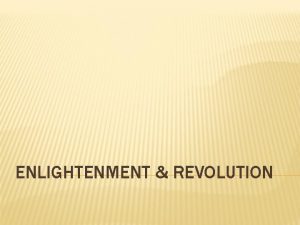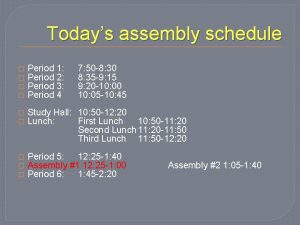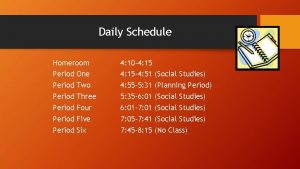Scientific Revolution n n n Scientific Revolution Period










- Slides: 10

Scientific Revolution

n n n Scientific Revolution Period of time in which a new way of thinking came about. The beliefs held by many for so long were now being questioned. Use logic and reason to solve the problems of the world (Secular not church thought) New ideas about the solar system such as Copernicus’ Heliocentric theory and inventions like Galileo’s telescope allowed scientists to learn more about the universe. Also, many new medical discoveries were made. Anton van Leeuwenhoek used a microscope and first saw red blood cells.

THE SCIENTIFIC REVOLUTION 1500’s when people started to challenge the old ideas about the world The Scientific Method – approach to science using experimentation and observation n n Copernicus – Heliocentric (theory that the world revolves around the sun) Galileo – helped proved Heliocentric theory Isaac Newton – Newton’s Laws of Physics Brought upon Enlightenment! Copernicus Heliocentric Theory

Secular n n n Secular teachings occurred during the Renaissance in Italy Secular teachings were more concerned with worldly matters rather than spiritual Secular teachings went against the church Some church leaders though became more worldly rather then sticking with the church They began to live in mansions, lavish banquets, and wore expensive clothing

Geocentric Theory n The belief that the earth was the center of the universe and everything else revolved around it.

Heliocentric (mid- 1500’s) n Nicholas Copernicus was a Polish scholar who challenged the common belief that the Earth was the center of the universe. n Copernicus suggested that the universe actually revolved around the Sun. n This theory was called heliocentric. n At the time most scholars rejected Copernicus’s theory.

Copernicus-1500’s n Developed the Heliocentric or sun-centered theory n Theory stated that the sun is the center of the universe and that everything revolves around it n It took Copernicus 25 years of studies to come up with this theory He wrote a book on his findings but feared persecution. He therefore didn’t publish it until 1543. He received a copy of his book on his death bed. n

Galileo n n n Galileo Galilei was a young Italian scholar, who discovered the law of the pendulum and proved Aristotle’s idea to be wrong, by watching a chandelier swing on its chain, and timing it with his on pulse and discovered that each swing of the pendulum took the exact same amount of time. In another study, Galileo found that falling objects accelerate at a fixed and predictable rate. He again proved Aristotle’s findings to be wrong. Aristotle had stated that heavier objects fall faster than lighter ones. From the Tower of Pisa, Galileo dropped items of different weights, and calculated how fast each one fell. Contrary to Aristotle’s belief, the objects fell at the same speed. Galileo had found out that a Dutch lens marker had built an instrument that would allow the looker to enlarge far-off objects. Galileo had not even seen this device, yet he was able to build his own, and with a few adjustments he was able to use his version of the telescope to study the stars. In 1610, Galileo had a series of newsletters published called the Starry Messenger, which described his astronomical discoveries. He described his findings on the planets, the constellations, etc. Galileo’s findings led to major conflict with the Church, since his findings proved the Church wrong. The Church did not want its followers to believe Galileo, because if they had known that they were wrong about the Solar System, they might be wrong about religion too.

n n n n ISSAC NEWTON Born January 4, 1643; Died March 31, 1727 At 25 years old he began revolutionary advances in math, physics, astronomy and optics. Sir Isaac Newton created the law of gravity and disproved Aristotle’s idea that every object attracts every other object In 1967 Isaac Newton published his book Mathematical Principles of Natural Philosophy This book is one of the most important scientific books ever written. He discovered that most everything in the universe could be expressed mathematically

n Scientific n n Method (1600’s) It is a logical procedure for gathering and testing ideas. n It begins with a question or problem arising from an observation. n Next you form a hypothesis n Then test the hypothesis by doing experiments and collecting data n Lastly, analyze and interpret data to reach a conclusion, that conclusion either proves or disproves your hypothesis The work of two important thinkers helped to advance the new approach: Francis Bacon n An English politician and writer n He criticized the way both Aristotle and medieval scholars arrived at their conclusions n He felt that they should experiment first and gather information, and than use that information to draw their conclusions (this is called the experimental method) Rene Descartes n Developed analytical geometry, which linked algebra and geometry n Like Bacon he believed scientists needed to reject old assumptions, but by using mathematics and logic n Everything should be doubted until proved by reason n “I think, therefore I am”
 Period 2 11 amu
Period 2 11 amu Cynthia lightfoot
Cynthia lightfoot Difference between history and prehistory
Difference between history and prehistory Critical period
Critical period Period of activism year
Period of activism year A&p flix activity: propagation of an action potential
A&p flix activity: propagation of an action potential Approaches to child development
Approaches to child development Stability period vs measurement period
Stability period vs measurement period Is hyperpolarization the same as refractory period
Is hyperpolarization the same as refractory period The classical period started from 1750 to 1872
The classical period started from 1750 to 1872 Trustee period and royal period
Trustee period and royal period


















